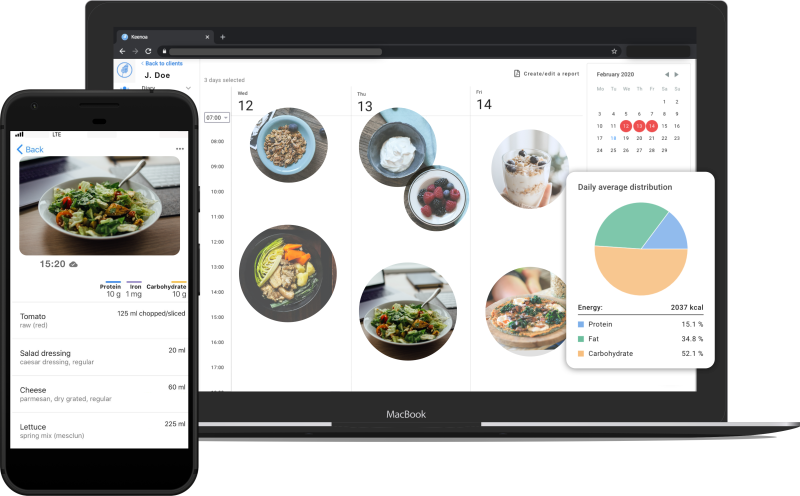Healthy Eating: The COVID Contradiction

By: Lynn Lafave
From education to eating, the pandemic has impacted every aspect of society. We asked Dr. Lynne Lafave, the co-author of Nutrition: A Functional Approach, how COVID-19 has affected our nutrition and how students can learn to build healthier eating habits during these stressful times.
How has COVID-19 affected nutrition habits?
A great deal of research world-wide has investigated predictors of healthy and unhealthy eating habits. Food prepared and eaten at home has been generally found to be healthier with higher nutrient density (more nutrients per calorie eaten) and lower energy overall. As a result, preparing and eating food at home is considered an eating habit associated with improved health and nutrient sufficiency.
In contrast, what we know is that adults, adolescents, and children are more likely to eat nutrient-poor energy-dense foods when the food is eaten away from home, school, or work. Examples of these nutrient-poor energy-dense foods include pastries, chips, soft drinks, and confections (candies and chocolate). The connecting characteristic is the ultra-processed nature of these foods and consuming larger proportions of these foods is a strong predictor of lower dietary quality and weight gain. Therefore, frequent eating food away from home is considered an unhealthy eating habit.
So, when various physical distancing restrictions were implemented to prevent the spread of COVID-19 and people spent more time at home, it seemed a reasonable hypothesis that this could lead to improved healthy eating. But nothing could have been further from the truth.
It seemed a reasonable hypothesis that spending more time at home during the pandemic could lead to improved healthy eating
Researchers quickly began to investigate the effects of COVID on eating habits and found some surprising results. In Italy, one of the first countries to institute lockdown measures, there was a significant increase in chips, sugary drinks, and red meat consumption among children and adolescents.
Evidence continues to trickle in demonstrating that poor dietary choices and increased drinking behaviours have increased world-wide as a result of the pandemic. In fact, Canada's Chief Public Health Officer, Dr. Theresa Tam, used her year-end 2020 address to caution Canadians about their higher alcohol consumption and encourage non-alcoholic options.
Why is the pandemic having a negative effect on eating habits?
To understand the impact of the pandemic on eating habits, we first have to understand factors that influence them.
Food choices are driven by a whole host of factors such as physiological aspects (hunger and appetite), cultural and social pressures, dietary components, familial and genetic factors, and cognitive-affective factors. Cognitive-affective factors such as perceived stress, anxiety, and depression may influence food choices which may help us to understand pandemic eating patterns.
Research has linked anxiety and stress to unhealthy lifestyle choices including the desire to eat and drink to feel better. This type of eating as a coping mechanism represents a stress-avoidance strategy of emotional eating to manage negative emotional experiences.
Popular culture addresses these ideas in media and comedy. Just think of a cartoon story about someone who has just broken up with their significant other, diving into a container of ice cream to drown their sorrows. Research evidence demonstrates that being in a state of sadness predisposes individuals to increased consumption of unhealthy foods.
In the COVID-19 context, the findings of unhealthy eating practices during the pandemic make sense. The lack of emotional support of friends and family could explain stress eating and poor food choices.
For university and college students, juggling schoolwork, part-time jobs, and cooking can be challenging even in the best of times. With the added loneliness, overwhelm, job loss, and exacerbated student mental health crisis in the pandemic, many students may be turning to food for comfort or choosing cheap unhealthy food to save money.
In the pandemic, many students may be turning to food for comfort or choosing cheap unhealthy food to save money.
Working with my co-author, assistant nutrition professor at Brescia University College Dr. Brenda Hartman, we decided to dedicate a section of Nutrition: A Functional Approach to the influence of sensory data, sociocultural cues, emotions, and learning on food choice behaviours in hopes that students can gain a deeper understanding of what’s behind their food choices and how to build a positive relationship with food.
What is one way we can build healthier eating habits during stressful times?
Awareness, emotional honesty, and mindful eating are important tools for personal health in a pandemic. Becoming aware of the "cues" that trigger unhealthy eating patterns can often be very helpful.
There is a strong movement in society to stop and reflect on one’s feelings to take stock on what is going on. This requires a level of emotional honesty with one self, to truly be connected with your feelings and claim them. In the context of nutrition, this type of self-awareness—sometimes called emotional acuity—allows one to reflect on one’s own relationship with food and thoughts about one’s own physical hunger and satiety cues.
Healthy eating is more than just our food choices. Our emotional state, the environment in which we eat, and the people we are eating with can meaningfully impact the way we view food, the speed at which we eat, and how much we eat.
Healthy eating is more than just our food choices.
When writing Nutrition: A Functional Approach with my collaborators, we wanted to focus on this holistic, functional view of nutrition so students can see how nutrition relates to their daily lives. Throughout the text, nutrition facts are linked to students’ circumstances, lifestyles, and current events in a narrative they can relate to and understand personally, even for students without a strong math and science background.
We wanted to focus on this holistic, functional view of nutrition so students can see how nutrition relates to their daily lives.
One of the practices to share with student is the art of mindful eating. Mindful eating is the nonjudgmental acceptance of physical and emotional feelings while eating and the choosing of nutritious pleasurable foods while being fully present in the moment undistracted from other activities. By recognizing the importance of their eating environment, students can learn to be more in touch with the food they choose to eat.
Students can learn to be more in touch with the food they choose to eat.
To help students gain a deeper understanding of the food they eat, nutrition students reading Nutrition: A Functional Approach this year will be able to use Keenoa, a food tracker nutrient analysis program that is also used by dietitians.

By taking pictures of their meals, students can get all of their nutritional information and quickly detect eating patterns using Keenoa.
This Canadian program will hopefully encourage them to develop more self-awareness around their eating habits and nudge them to consider ways to improve their own eating habits.
Learn more about how Nutrition: A Functional Approach can inspire your students apply nutrition to their lives

Lynne Lafave earned a Ph.D. in nutritional sciences from the Department of Food and Human Nutritional Sciences at the University of Manitoba. She is an active member of the Dietitians of Canada and is a co-author of Pearson Canada’s Nutrition: A Functional Approach, 4ce.
Lynne’s primary research focuses on designing and assessing the impact of nutrition and physical activity interventions with a focus on early childhood education and care environments. This has resulted in CHEERS, a novel assessment tool for this community to provide evaluation and feedback on the eating and active environments in child care (https://cheerskids.ca). Her research also includes investigating the role of food literacy in preschool-aged children’s dietary health within a community-based participatory research approach. She is an associate professor in the Department of Health and Physical Education at Mount Royal University in Calgary, Alberta where she teaches nutrition, statistics, and research methods courses.